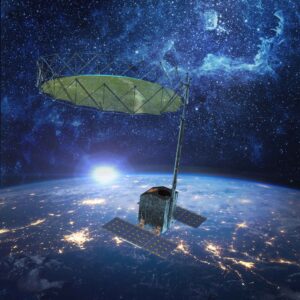L3Harris developing a constellation of small spy satellites for U.S. Air Force
By Sandra Erwin

WASHINGTON — L3Harris Technologies has launched the first satellite of a remote sensing constellation it is developing for the U.S. Air Force.
In a July 6 news release, L3Harris said the constellation of small satellites will provide imagery to military operators on the ground. “The company will task, command and control the satellite system, as well as perform on-board processing of data to deliver imagery products directly to warfighters.”
Ed Zoiss, president of L3Harris Space and Airborne Systems, told SpaceNews that the company deployed the first satellite of the constellation two years after receiving a fixed-price contract from the Air Force. The program is classified, so details such as the value of the contract, the date of the launch or the vehicle that flew the satellite cannot be disclosed.
Zoiss said that despite the sensitive nature of the program, the Air Force allowed L3Harris to reveal its existence as an example of a “responsive space” system that has moved at a pace rarely seen in military space programs.
The idea of responsive space — a shift from large expensive satellites that take a decade or longer to develop to more nimble systems — has been talked about inside DoD and the intelligence community for over a decade but change has been slow, said Zoiss.
There are now signs that government buyers are rethinking how to procure satellites, said Zoiss.
DoD satellite contracts typically are awarded to a spacecraft manufacturer that is also responsible for buying the sensor payloads. That approach doesn’t work for many customers that care more about the payload than about the satellite bus, said Zoiss.
This created a window of opportunity for L3Harris, which has deep expertise in space sensors and instruments. The company started offering fully integrated satellites directly to the government, bypassing the traditional prime contractors like Lockheed Martin or Boeing, Zoiss said. “Customers come directly to us as a key payload provider and they don’t care what bus we use.”
“We reshaped our business around the ability to deliver full end-to end-systems,” he said. “We transformed from a component provider and a payload provider to exquisite systems, to now a full prime.”
Harris Corp. was moving down this path before the 2019 merger with L3 Technologies. Since the merger, the push to compete for defense contracts as a satellite prime contractor has accelerated under the combined L3Harris.
A year ago the company stood up the Space and Airborne Systems division, based in Melbourne, Florida, which accounts for $5 billion of L3Harris’ $18 billion in annual sales. Zoiss said his unit is made up of “80% legacy Harris space and intelligence, and some key pieces from L3.”
Zoiss said L3Harris is now a satellite prime contractor in several classified programs. And it’s considering bidding as a prime contractor in future DoD missile warning constellations.
“At the end of the day we’re going to choose where we compete as prime, as opposed to as a payload provider,” he said.
Zoiss mentioned the Air Force Research Laboratory’s Navigation Technology Satellite-3 program as an example of the shift happening in the DoD space business.
In December 2018 Harris Corp. was selected as the prime contractor for the NTS-3 experiment to be launched in 2022. The central technology in this program is the navigation payload that L3Harris supplies to Lockheed Martin for the Global Positioning System satellites.
For the NTS-3 experiment, L3Harris is building a satellite with the GPS payload and a Northrop Grumman ESPAStar bus.
The navigation payload’s mission data unit is the “heart of GPS,” said Zoiss. “AFRL recognized that and awarded us their experiment contract. They didn’t award it to LockheedMartin or to Northrop Grumman. They said to us ‘you go pick a bus.’”
The contract includes options for the Air Force to buy up to nine satellites. Zoiss said the NTS-3 program has piqued the interest of countries like the United Kingdom and South Korea. “They are watching what we’re doing with NTS-3 and looking at potentially using those as a baseline for a GPS constellation,” he said. “I think this program has legs past what we’re doing with the DoD.”
July 6, 2020 at 05:46PM
via SpaceNews read more...

Post a Comment